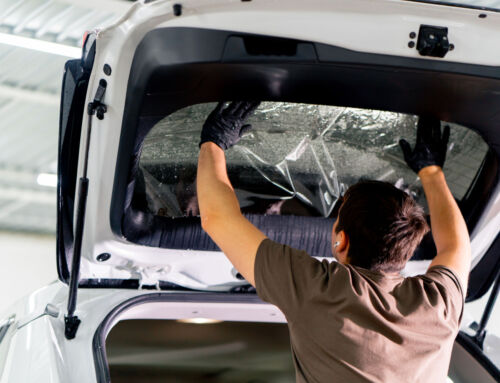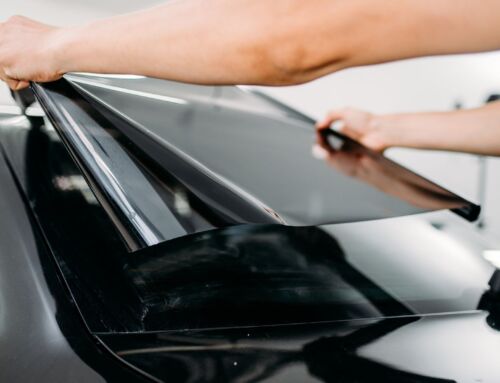Window Tinting Laws: Everything Tint Shops Need To Know
Understanding Window Tinting Laws is essential for tint shops and mobile tinters to provide compliant services and avoid fines. These laws govern how much tint can be applied to vehicle windows ensuring driver safety or legal compliance and customer satisfaction. This guide covers everything tint professionals need to know about Window Tint Percentage Limits or state regulations and compliant tinting options. Read on to learn more.
Understanding Window Tint Percentage Limits
Window Tint Percentage Limits refer to the amount of light that can pass through a vehicle’s windows after applying tint. This measurement called Visible Light Transmission (VLT) is expressed as a percentage. A lower VLT percentage means the tint is darker and allow less light to enter the vehicle. On the other hand, a higher percentage indicates a lighter tint that lets more light through.
Why Do VLT Limits Matter?
VLT limits exist to ensure that drivers maintain adequate visibility while on the road, especially in low-light or nighttime conditions. They also allow law enforcement and emergency personnel to see inside vehicles when necessary for safety and security reasons. Understanding these limits is vital for tint shops to avoid Window Tinting Fines and offer clients tints that comply with state regulations.
Examples of Legal VLT Limits by State:
Every state has specific window tinting laws governing how dark a tint can be for different windows on a vehicle. Here are a few examples of Window Tint Percentage Limits:
Tint shops must understand these limits to avoid Window Tinting Fines and to provide accurate guidance to their clients.
The Importance of Using Correct VLT Percentages:
Applying the correct VLT percentages ensures that vehicles are both safe and legally compliant. A legal tint not only avoids penalties but also enhances the safety of drivers and passengers by improving visibility. Additionally, compliant tints protect your business from liability and build customer trust.
Legal Tinting Options For Clients
Providing Legal Tinting Options ensures that customers remain within the bounds of the law. These options vary based on state regulations and include:
Tint shops educate clients about Window Tinting Laws and the permissible tinting options helps them make informed decisions.
Navigating Window Tinting Laws By State
Each state has unique Window Tinting Laws that govern the allowable tint percentages for windshields, side windows, and rear windows. These laws specify the allowable level of window tint for different parts of a vehicle and may vary significantly depending on the type of vehicle and the location. For tint shops, understanding these regulations is key to providing compliant services and avoiding Tinting Law Violations.
Front Windshields:
Most states regulate the amount of tint allowed on front windshields to ensure clear visibility for drivers. Typically, states permit a small, non-reflective strip of tint at the top of the windshield, often referred to as the AS-1 line. This strip helps reduce glare from the sun without obstructing the driver’s view.
Side and Rear Windows:
The Visible Light Transmission (VLT) percentages allowed for side and rear windows vary depending on the vehicle type. Generally, passenger cars, SUVs, and vans have different limits, with SUVs and vans often allowed darker tints for privacy or comfort.
Table of State Tinting Regulations:
The table below provides a quick reference to State Tinting Regulations for front windshields, front side windows, rear side windows, and back windows. It highlights the differences between states and offers valuable information for tint shops and customers.
|
State |
Front Windshield |
Front Side Windows |
Rear Side Windows |
Back Windows |
|
California |
Non-reflective tint above AS-1 line |
At least 70% VLT |
No restrictions |
No restrictions |
|
Florida |
Non-reflective tint above AS-1 line, max 25% reflectivity |
At least 28% VLT |
15% VLT for passenger cars; no limit for SUVs/vans |
15% VLT for passenger cars; no limit for SUVs/vans |
|
Texas |
Non-reflective tint above AS-1 line |
At least 25% VLT |
No restrictions |
No restrictions |
|
New York |
Non-reflective tint above AS-1 line |
At least 70% VLT |
At least 70% VLT |
No restrictions |
|
Arizona |
Non-reflective tint above AS-1 line |
At least 33% VLT |
No restrictions |
No restrictions |
|
Georgia |
Non-reflective tint above AS-1 line |
At least 32% VLT |
At least 32% VLT |
At least 32% VLT |
|
Nevada |
Non-reflective tint above AS-1 line |
At least 35% VLT |
No restrictions |
No restrictions |
|
Michigan |
Top 4-inch strip only |
No tint allowed |
No restrictions |
No restrictions |
|
Minnesota |
No tint allowed |
At least 50% VLT |
At least 50% VLT |
At least 50% VLT |
|
Vermont |
No tint allowed |
No tint allowed |
At least 35% VLT |
At least 35% VLT |
|
North Carolina |
Non-reflective tint above AS-1 line |
At least 35% VLT |
At least 35% VLT |
At least 35% VLT |
|
Colorado |
Non-reflective tint above AS-1 line |
At least 27% VLT |
At least 27% VLT |
At least 27% VLT |
|
Alabama |
Non-reflective tint above AS-1 line |
At least 32% VLT |
At least 32% VLT |
At least 32% VLT |
|
Indiana |
Non-reflective tint above AS-1 line |
At least 30% VLT |
At least 30% VLT |
At least 30% VLT
|
|
Missouri |
Non-reflective tint above AS-1 line |
At least 35% VLT |
No restrictions |
No restrictions |
Ensuring Window Film Compliance
To maintain Window Film Compliance, tint shops must use materials that meet federal and state regulations. Compliance not only protects your business but also builds trust with your customers. Steps to ensure compliance include:
Medical Exemptions For Tinting
Certain individuals qualify for Medical Exemptions for Tinting due to conditions that make them more sensitive to sunlight, such as lupus or albinism. These exemptions allow for darker tints than typically permitted. Here are the requirements for Medical Exemptions:
By educating clients about medical exemptions, tint shops can assist those who need specialized solutions while ensuring compliance with the law.
DIY Window Tinting Regulations
Some customers may attempt to install their own tints, but they often overlook DIY Window Tinting Regulations. Common pitfalls include:
Encouraging clients to seek professional installation guarantees a polished finish and adherence to Safety Standards for Window Tinting.
Regional Variations In Tinting Laws
Tinting Laws by Region reflect local climate and safety needs. For example:
Understanding these regional differences helps tint shops recommend the best options for their customers while ensuring legal compliance.
Common Tinting Law Violations
Violating Automotive Window Tint Laws can result in severe penalties. Common Tinting Law Violations include:
How to Avoid Violations:
By avoiding violations, tint shops protect their reputation and save their clients from costly Window Tinting Fines.
Benefits Of Using Popular Window Tint Films
Recommending Popular Window Tint Films ensures customer satisfaction while maintaining compliance. Some common options include:
Advantages of Compliant Window Tint:
Compliant window tint enhances privacy and security by limiting visibility into the vehicle, protects passengers and interiors from harmful UV rays and reduces glare for improved visibility. Highlighting these benefits helps clients understand the importance of choosing legally compliant tints for safety and comfort.
Following Tinting Installation Guidelines
Adhering to proper Tinting Installation Guidelines ensures high-quality results and compliance. Key steps include:
These practices maintain Safety Standards for Window Tinting, ensuring customer satisfaction and long-lasting installations.
Why Partner with TMR Films?
TMR Films provides top-quality window films that meet Safety Standards for Window Tinting while offering excellent durability and performance. Partnering with a reliable supplier like TMR Films ensures your business has access to compliant, premium-grade products.
Window Tinting FAQs
Question 1. What’s the darkest legal tint in my state?
Answer: Tint laws vary by state. For example, California requires 70% VLT for front side windows, while Florida allows 28%. Check your state’s DMV website to confirm the specific Window Tinting Laws applicable to your area.
Question 2. Can I tint my windshield?
Answer: Most states allow a non-reflective strip above the AS-1 line, but rules vary. Confirm with your state’s regulations to ensure compliance.
Question 3. Do medical exemptions apply nationwide?
Answer: Medical exemptions are state-specific with varying requirements and procedures. Contact your state’s DMV to learn about eligibility and application.
Conclusion:
Adhering to Window Tinting Laws builds trust and ensures quality. By offering Legal Tinting Options and staying updated on State Regulations, you can provide safe, compliant, and professional services. TMR Films offers premium, compliant window films to help your business succeed. Contact us today to elevate your tinting services and ensure customer satisfaction!



